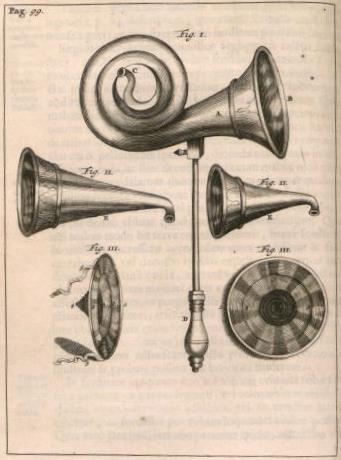We may take it as a given that our hearing aids are hardly detectable, can be managed with our cell phones, and can discern between speech and background sound. What we might not realize, however, is that those capabilities are the products of 400 years of experiment, design, and enhancement.
Even 5 years ago, hearing aids could not generate the clarity of sound produced at present. To understand why, let’s track the history of hearing aids—beginning today and going in reverse—to observe how hearing aids would have handled your hearing loss in four different years: 2016, 1985, 1940, and 1650.
2016 – Modern Day Digital Hearing Aids
It’s 2016 and you’re looking to treat your hearing loss. You open up a web browser, search for a nearby hearing care professional, fill out a brief form, and schedule an appointment.
At your hearing assessment, your hearing is tested using state-of-the-art computer technology that precisely evaluates your hearing. Then, with the assistance of your hearing consultant, you decide on a hearing aid that satisfies your needs from a wide selection of models.
Then, your hearing specialist programs your new hearing aids to intensify only the sounds and frequencies you have difficulty hearing, leading to crystal clear sound without distortion.
If you told anyone in the 1980’s that this would be the process, they wouldn’t have thought it was possible.
So what did render it possible? In essence, digital technology.
For most of their history, there was no way for hearing aids to discern between various sound frequencies. Hearing aids would magnify all incoming sound, including background noise, producing distorted sound.
The digital revolution addressed that problem. With digital technology, all information can be altered, stored, and manipulated as combinations of 0’s and 1’s. Digital technology permitted hearing aids to convert sound frequencies into digital information, which could then be categorized based on which sounds should be amplified (speech) and which should be restrained (background noise).
The first all-digital hearing aid was created in 1995, and since that time the technology has improved significantly, eventually to include wireless capability.
1985 – Transistor Hearing Aids
Now, imagine it’s 1985 and you’re planning to treat your hearing loss. You can forget about searching for a local hearing care provider on the internet because the first commercial internet service provider won’t be established until 1989.
You’d have to use the yellow pages, depend on referrals, or drive around the neighborhood to find a hearing care practice.
After scheduling a consultation and having your hearing tested, your choices for hearing aids are quite restricted. With no microprocessor and digital technology, hearing aids were built with a sequence of transistors. This adds size and increased power requirements, resulting in larger batteries and larger hearing aids.
Additionally, without the advantage of digital technology, the hearing aid can’t differentiate between various frequencies of sound. Hearing aids receive incoming sound and the transistors act as basic amplifiers, amplifying all sound. So if you’re in a noisy room, speech recognition will be nearly impossible.
1940 – Vacuum Tube Hearing Aids
It’s 1940 and you’re considering buying a hearing aid. Transistors haven’t been applied to hearing aids yet, so your choices are confined to vacuum tube hearing aids.
Vacuum tubes consume more power than transistors, so the hearing aids call for larger batteries, making the hearing aids big, heavy, and cumbersome.
And once again, without digital technology, the hearing aids can only act as basic amplification systems, making all incoming sound louder. The hearing aids cannot enhance speech and can’t filter out background noise.
1650 – Ear Trumpets
Let’s go all the way back to 1650. There’s no digital technology, no transistors, and no vacuum tubes. As a result, there is no way to transform sound into electrical currents that can be amplified.
With electrical amplification unattainable, your only choice is mechanical amplification by focusing and compressing sound into the ear canal, as with what takes place when you cup your hands around your ears.
By 1650, products were developed that concentrated inbound sound into the ears, and these contraptions were labeled ear trumpets. They were prominent gadgets with a conical end that picked up sound and a narrow end that concentrated the sound into the ear.
This would be the only technology available to those with hearing loss for the next 250 plus years.
Let’s return to 2016. Throughout more than 400 years of history, hearing aids have develop from mechanical amplification devices to electrical amplification devices, from vacuum-tube-based to digital-based. They’ve come to be progressively smaller, lighter, and more efficient and affordable.
They’ve also become much better at distinguishing among various types of sound, and in amplifying only particular kinds of sound (like amplifying speech while repressing background noise).
Every generation of hearing aid has produced a significant upgrade over the previous generation. The question is, what’s the next great benchmark in the history of hearing aids?
Will we eventually be able to improve natural human hearing, rather than simply restore it?

